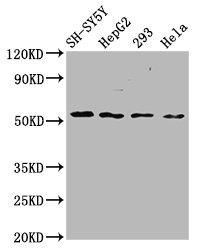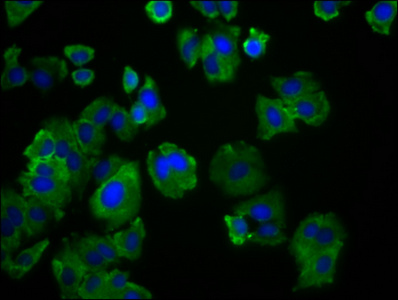Full Product Name
Rabbit anti-Homo sapiens (Human) SLC19A3 Polyclonal antibody
Alternative Names
SLC19A3Thiamine transporter 2 antibody; ThTr-2 antibody; ThTr2 antibody; Solute carrier family 19 member 3 antibody
Immunogen
Recombinant Human Thiamine transporter 2 protein (191-282AA)
Immunogen Species
Homo sapiens (Human)
Conjugate
Non-conjugated
The SLC19A3 Antibody (Product code: CSB-PA866333LA01HU) is Non-conjugated. For SLC19A3 Antibody with conjugates, please check the following table.
Available Conjugates
| Conjugate |
Product Code |
Product Name |
Application |
| HRP |
CSB-PA866333LB01HU |
SLC19A3 Antibody, HRP conjugated |
ELISA |
| FITC |
CSB-PA866333LC01HU |
SLC19A3 Antibody, FITC conjugated |
|
| Biotin |
CSB-PA866333LD01HU |
SLC19A3 Antibody, Biotin conjugated |
ELISA |
Purification Method
>95%, Protein G purified
Concentration
It differs from different batches. Please contact us to confirm it.
Buffer
Preservative: 0.03% Proclin 300
Constituents: 50% Glycerol, 0.01M PBS, pH 7.4
Tested Applications
ELISA, WB, IF
Recommended Dilution
| Application |
Recommended Dilution |
| WB |
1:500-1:5000 |
| IF |
1:50-1:200 |
Storage
Upon receipt, store at -20°C or -80°C. Avoid repeated freeze.
Lead Time
Basically, we can dispatch the products out in 1-3 working days after receiving your orders. Delivery time maybe differs from different purchasing way or location, please kindly consult your local distributors for specific delivery time.
Description
CUSABIO uses the recombinant human SLC19A3/ThTr2 protein (191-282AA) to immunize rabbits and then purify the rabbit antiserum through protein G to obtain the anti-SLC19A3 antibody. This SLC19A3 antibody is a polyclonal antibody and occurs as an unconjugated IgG. Its purity reaches up to 95%. It only shows reactivity with human ThTr2 protein, a thiamine transporter that modulates high-affinity thiamine absorption through a proton anti-port mechanism. And this anti-SLC19A3 antibody has been validated for use in ELISA, WB, and IF applications.
Usage
For Research Use Only. Not for use in diagnostic or therapeutic procedures.








